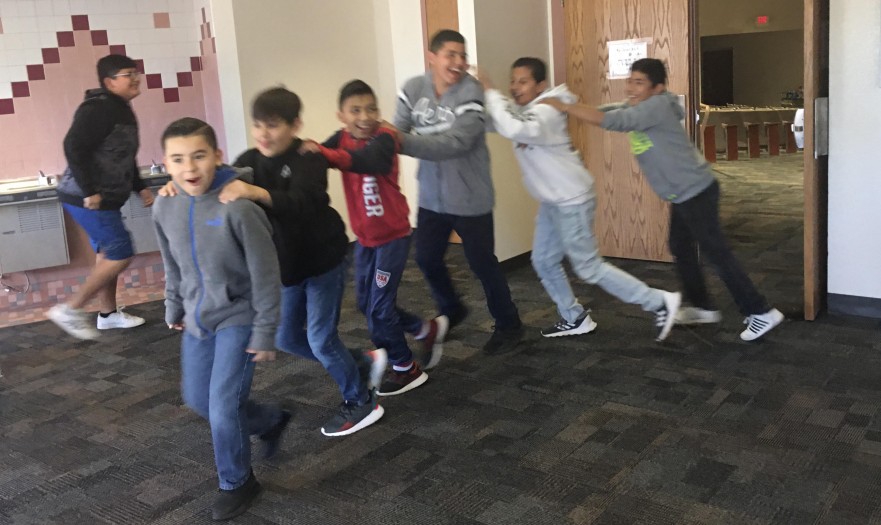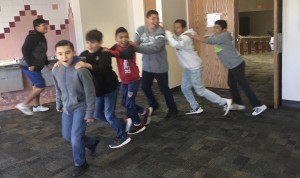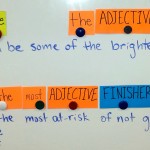Today was the first day of AZELLA testing for my 7th grade introduction level English Language Development class. They were very nervous during the first subtest (Listening), and then we had quite a bit of time to relax. It wasn’t worth starting the next subtest until after lunch.
We thought about watching some Spongebob, but one of the proctors reminded us that screen time is not good for testing brains. So I pulled out my trusty Yoga Pretzels card pack (best thrift shop purchase ever), and gave the kids some guidelines, mostly just to avoid injury! We moved to the auditorium lobby and I spread the cards out on a table, recommending poses that kids had enjoyed in the past and letting the students shuffle through the cards.
They immediately paired up or went into a corner alone and started trying out poses, giving up, doing it their own way, laughing, falling over, trading the cards that described poses for new ones. It made me smile to see them interact without devices or the pressure of the cafeteria line.
The scene soon evolved. The cards returned to the table one by one. The three girls in my class of 14 moved toward the corner of the room and demonstrated for me various techniques of getting into an upward bow pose (apparently popular among child gymnasts and cheerleaders) while the boys began devising other games.
First they did a wall sit challenge where each boy sat on the other’s lap to make a long line until the one doing the wall sit was ready to collapse. Then they played tag. That transitioned into them doing a conga line, which turned into holding hands and running in a circle as fast as they could until they flung apart from one another. I was completely charmed by the sepia-toned nostalgia of this last moment.
After several configurations of this less-annoying version of the circle game than is usually witnessed in junior high, they decided to build a human pyramid with the three largest boys on the bottom (although I never saw this happen, in case anyone asks. I am sure it is not regulation.) Next they started riding each other like horses, like your dad would have given you a ride across the living room when you were four years old. The ones who weren’t riding were laughing and enjoying the whole scene. Then they moved to leapfrog. Then Marco Polo, with a hooded sweatshirt put on backward over their face as a blindfold.
I could hardly believe what I was seeing, but didn’t want to look too astounded and break the spell. I knew that these boys loved to go to the park on weekends and play soccer more than anything else, but I didn’t realize their complete capacity to entertain themselves with social and physical play.
Throughout most school days, any time kids get a break, someone will bust out a cell phone and three others will gather round and witness whatever goofy video pops up on Snapchat or Tik Tok next. Either that or they meander through the hall, shoving into their friends, “necking” each other, committing PDA (which, these days, necking is not), saying things just low enough so a teacher can’t hear, yelling in the bathroom or just trying to negotiate their way through all of that to the next class.
Our brain break was a whole other scenario, one of camaraderie, inclusivity and friendly competition, and one of joy. Maybe my students are just special, or maybe our school is onto something.
Here are some things I thought and wondered about during and after our break:
- Many 7th graders are not as engrossed in the digital world as we may think they are, or at least that is not their natural habitat the way we sometimes assume.
- These kids are really, truly still children, although we sometimes forget that in the midst of our high expectations.
- Giving older kids the opportunity for unstructured outdoor play (recess) may really be paying off for our students. In addition to opening up the fields during lunch recess, at least once a week our team takes all 185 kids outside for 20-30 minutes of supervised, but unstructured, play. Some gather at the garden to nibble or see what is new, some organize basketball games, some play frisbee, some look at photos and videos on their phones, and more than you would think choose to run around like little primary grade kids and play tag. I wonder what long-term benefits might come from this opportunity for interactive play?
At the end of our break, the students returned to their testing seats flushed, several with sweat running down their temples. I knew that after lunch they would return in good spirits, ready to tackle their reading test with whatever language skills they could muster, and hopefully that will pay off.











Comments 7
I love this with all my heart! I’ve seen such a decline in play in schools and students today so it is so refreshing to see it in action. Your students are so lucky to have you and your environment! I’m drafting a piece involving your wonder, “I wonder what long-term benefits might come from this opportunity for interactive play?”
That is so great! Thanks for reading and adding to the conversation. I know there has been research in this area, and that there must certainly be LOTS more to say on the topic!
I should probably edit this to note that I also did not witness the kids playing tag. I am pretty sure that is not regulation, either.
I’m so glad your posted this! It is something I’ve observed in my K-8 school–the need for “big kids” to just play! I know it will be a hard transition to 9th grade when playing during lunch time is limited. But how valuable it is! Thank you for this post. It’s given me a lot to think about.
Your post made me smile while I was reading. We see the serious and focused side of students in our classrooms so often that it is so refreshing to watch our students be silly and play with each other!
YES! Middle schoolers are too often expected to be ‘little big kids’ too quickly. One of the campuses I’m lucky enough to be on has a basketball court embedded into its’ interior courtyard area and, without a doubt, students seek out these courts even in passing periods. Play is so very important!
Thank you for posting this. Any opportunity that we can give our children to simply be children is a beautiful gift. I am sure they appreciated the opportunity more than we realize.